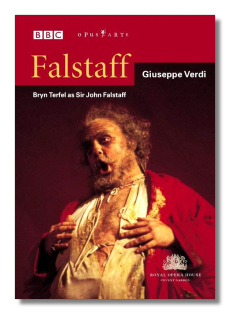
The Internet's Premier Classical Music Source
Related Links
- Verdi Reviews
- Latest Reviews
- More Reviews
-
By Composer
-
Collections
DVD & Blu-ray
Books
Concert Reviews
Articles/Interviews
Software
Audio
Search Amazon
Recommended Links
Site News
 DVD Review
DVD Review
Giuseppe Verdi

Falstaff
- Bryn Terfel (Falstaff)
- Barbara Frittoli (Alice)
- Diana Montague (Meg)
- Roberto Frontali (Ford)
- Desirée Rancatore (Nannetta)
- Kenneth Tarver (Fenton)
- Bernadette Manca di Nissa (Quickly)
- Robin Leggate (Dr. Caius)
- Peter Hoare (Bardolph)
- Gwynne Howell (Pistol)
Orchestra & Chorus of the Royal Opera House, Covent Garden/Bernard Haitink
BBC Opus Arte OA0823D DVD 157min
The production presented here, and originally broadcast live by the BBC in December 1999, inaugurated the renovated Royal Opera House at Covent Garden. Visually, there is much to be entertained by, although it must be said that this is not a very funny Falstaff, both dramatically and musically. Graham Vick's production is garishly colored and full of surreal distractions, such as beds that get sucked into and out of the stage, and trees that pop out of the ground. The opening scene in The Garter Inn actually takes place in Falstaff's gigantic bed, and when the action supposedly returns to that location in the first scene of Act Three, the deer heads that had been on the wall and the chessboard that had been on the floor have exchanged positions. Who knows what this means. The second scene of Act One seems to take place on a miniature golf course designed by a sadist. Later, the Ford household is invaded by apparent escapees from Cirque de Soleil in the second scene of Act Two, and the same personages return in the final scene as a Herne's Oak comprised of human bodies – a creepy yet admittedly rather beautiful idea. Fenton is dressed like Petruchio from Kiss Me Kate, Nannetta like a frumpy Cinderella, and Falstaff himself wanders around in a generously padded body suit – nearly naked by the end of the opera. He, Bardolph, and Pistol sport exaggerated codpieces. In general, the singers generally seem distracted by their surroundings and by the gymnastics that they are required to perform.
Bernard Haitink is always a dependable conductor. He is not the first maestro to come to mind, however, when infectious sparkle is needed, and nothing of the kind comes out of the orchestra pit at any time during this performance. The brass playing is particularly coarse. At least Haitink never swamps the singers.
Bryn Terfel's interpretation of the title role is the best reason to acquire this DVD. (Indeed, the front of the DVD box acknowledges him alone among the performers.) His Falstaff, arrogant, yet susceptible, is consistently lovable, and he conscientiously attends to his singing – and Verdi's music – as well as to his acting.
Among the women, Frittoli and Montague sing well, but without much individuality. Frittoli, funny in an understated way, is the better actress of the two. Rancatore is an adorable, zaftig Nannetta, and she sings her fairy aria sweetly, in spite of the fact that she must do so while sitting on another character's shoulders. The Dame Quickly of Manca di Nissa is very competent, and I blame her baggy costume for stifling her personality.
Tarver's Fenton is ardent and expressive; he and Rancatore add some necessary humanity and vocal warmth to this production. Leggate excels as the pedantic, squawking Caius, and Hoare and Howell cut grotesque figures as Falstaff's henchmen. Frontali's Ford is well acted, but his dry voice prevents his Act II aria from having the desired impact.
Memorable and brilliant singing is not abundant in this production, and neither is subtlety, but this is an enjoyable Falstaff as long as one doesn't hope for humor of the profounder kind. Only during the fugal finale do the singing, acting, and stage conception come together to move the listener and to convince him how great this opera really is.
The 16x9 anamorphic video quality is fine, as is the sound, albeit the latter is a little cavernous. The inclusion of 31 separate index points makes it easy to find one's favorite highlights. Extra features on the DVD include a segment with Vick, an interview with Terfel, and a "meet the backstage crew" segment.
Copyright © 2002, Ray Tuttle


















